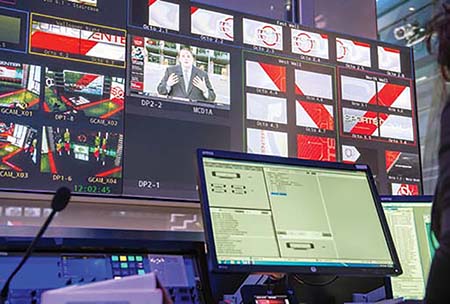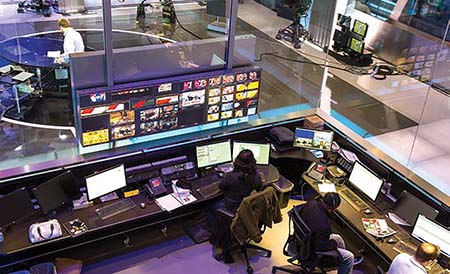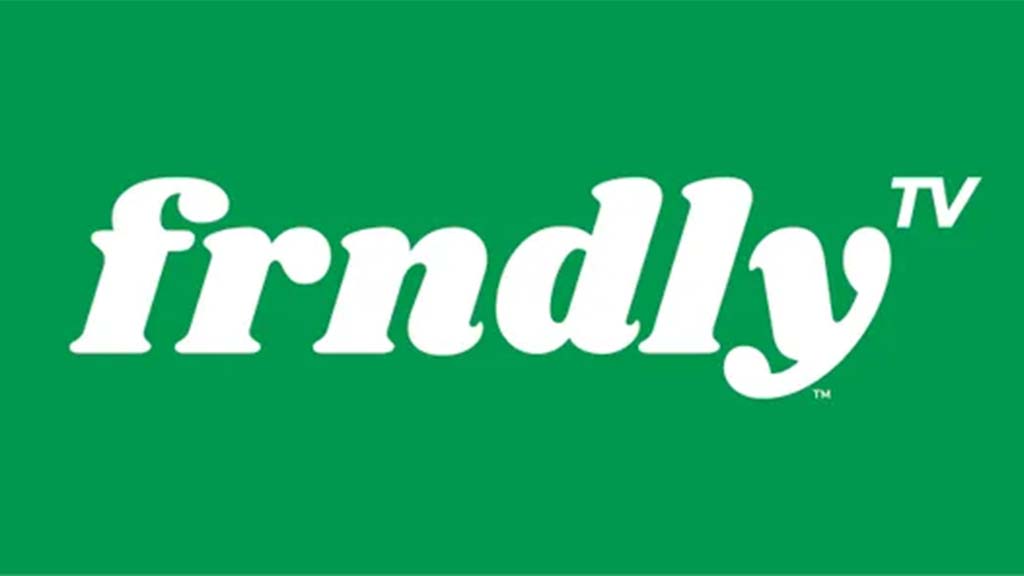Driving the Displays

The Octoviz in the SportsCenter AnnexBRISTOL, CONN.—With the freedom to display real-time video clips and graphics in virtually any configuration on its 127 on-set monitors, ESPN’s “SportsCenter” raises the bar on live studio news and sports production.
ESPN’s new Digital Center-2 (DC-2), which opened last June on its Bristol campus, houses the 10,000 square-foot “SportsCenter” studio, a visually rich eye candy showcase where imagery splashes across wall, floor and banner displays.
At the epicenter of this live moving image experience is Octoviz, a one-of-a-kind innovation—imagined by ESPN and co-developed with Vizrt—that controls the displays of real-time graphics across any combination of on-set monitors in their native resolutions and aspect ratios.
MAINTAIN SAME WORKFLOW
“When we were planning this cutting-edge ‘SportsCenter’ studio design, there was nothing on the market capable of putting live graphics into 127 monitors cost-effectively,” said Stefanie Gjorven, senior director, technical operations and engineering for ESPN. “Also, from an engineering standpoint, we didn’t want to introduce any new technology that would change our familiar graphics workflow.
“Since the existing graphics workflow lets us search and utilize our extensive media asset library, being able to quickly deliver that content to the 127 monitors would be vital to creating a valuable user experience, especially in a breaking news situation,” Gjorven said. “So we asked Vizrt if they would help us create a custom solution to solve this technical display challenge in a way that seamlessly interfaces with our existing workflow.”
With 12-month’s lead time before ESPN’s planned DC-2 and “SportsCenter” studio opening, Vizrt’s research and development team in Austria began modifying its Viz Engine— the real-time video/graphics compositing and rendering system ESPN had been using to playout live graphics—to create Octoviz, the solution ESPN needed.
“While Octoviz was only meant to be the prototype name, over time people really liked it and it stuck,” Gjorven said. The solution provides eight channels of video processing and playout from a Viz Engine, hence the name Octoviz. Vizrt modified its Viz Engine by swapping out the single channel SDI video board for two Nvidia Quadro K6000 GPU graphics boards plus a component that synchronizes the two.
Get the TV Tech Newsletter
The professional video industry's #1 source for news, trends and product and tech information. Sign up below.

Overhead view of the Octoviz in the SportsCenter Annex “Since each Quadro K6000 outputs four DVI video channels, each Octoviz gives ESPN eight discreet channels of high-resolution [1080p HD or better] video in its native resolution cost-effectively,” said Isaac Hersly, president of Vizrt Americas, in New York. (At the 2014 IBC Show in September, Vizrt began marketing a solution called Viz Multiplay, which is based on the technology developed for ESPN, with the addition of front-end control software.)
SCALING UP
To scale up to deliver real-time video and graphics to the 127 on-set monitors, Hersly added, “ESPN configured eight Octoviz boxes together for a total of 64 DVI channels.” The 127 displays, which are distributed liberally around the large studio, are not fed or controlled by Octoviz all at one time.
The DVI video goes from Octoviz through a converter that losslessly compresses it to JPEG2000 so it can travel through DC-2’s IT plant. It then goes into an Evertz Puck, which converts the JPEG2000 back to DVI for input into the back of the displays.
While Vizrt was working on the video processing, ESPN’s in-house software development team, led by Oyvind Gjorven, application development manager for the network, wrote the front-end controls that would interface Octoviz with ESPN’s existing VCS template-driven graphics playout architecture, including the back-end asset database and AP/ENPS newsroom computer systems.
“Our operators can search our database for graphics or video and put them into predefined templates and layouts that are sent to a server in the production control room,” Gjorven said. “From there, Octoviz picks us the graphics for playout to the displays.” Graphics operators stationed in a glass control room adjacent to the set operate and control the Octoviz displays.
“Based on the user-determined layouts, our custom applications tell Octoviz how the graphics should display on the screens,” Gjorven added. “Our custom front-end drives all those different permutations for the operator to play-out and it’s intelligent enough to know how to fit the video to the dimensions of the display without compromising the quality.” For example, a six-monitor video wall on the studio’s east wall offers 32 different ways that graphics and video can be displayed.
On the north wall of the studio, a massive display called “The Loom” drives a custom in-house application. The Loom has 56 LED monitors arranged at different orientations and elevations, giving it a distinctive, multi-dimensional look. Octoviz, traditional Viz engines that play out graphics with video keys, and video inputs fed from the TD serve as inputs to The Loom.
DC-2’s “SportsCenter” Studio, which supports 24/7 programming, uses Octoviz and its many graphical displays—including touchscreen plasmas and an LED ticker banner—to create a distinctive brand for the network’s flagship sports news show.

